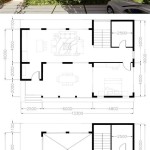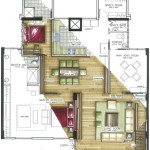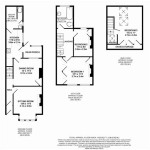Example of Floor Plan Drawing
Floor plans are scaled diagrams that show the relationship between rooms, spaces, and physical features viewed from above. They provide a way to visualize how people will move through a space and are essential for design and construction in various fields like architecture, real estate, and facility management.
Residential Floor Plans
Residential floor plans depict the layout of homes, apartments, and condominiums. These plans typically include room dimensions, locations of doors and windows, and the placement of fixtures such as sinks, toilets, and appliances. They are crucial for homeowners, builders, and interior designers to understand the flow and functionality of a living space.
A typical residential floor plan might include a kitchen, living room, dining room, bedrooms, bathrooms, and hallways. The arrangement of these spaces can vary significantly depending on the size and style of the home. For example, an open-concept floor plan might combine the kitchen, dining, and living areas into a single large space, while a more traditional layout might separate these areas with walls.
Commercial Floor Plans
Commercial floor plans illustrate the layout of businesses, offices, retail spaces, and other non-residential buildings. These plans often include details about HVAC systems, electrical wiring, plumbing fixtures, and safety features like fire exits and emergency lighting. They are vital for business owners, architects, and contractors to ensure the space meets the specific needs of the intended use.
A commercial floor plan for a restaurant might include designated areas for the kitchen, dining area, bar, restrooms, and storage. The layout would need to consider factors such as customer flow, efficient service delivery, and building codes related to food preparation and sanitation. Similarly, an office floor plan might incorporate individual offices, cubicles, meeting rooms, and common areas, designed to maximize productivity and collaboration.
Floor Plan Symbols and Notations
Floor plans utilize standardized symbols to represent various elements within a space. These symbols communicate information about walls, doors, windows, stairs, and other architectural features. Understanding these symbols is essential for accurately interpreting a floor plan.
Common symbols include thick lines for walls, thinner lines for windows and doors, arcs for door swings, and various shapes for fixtures like toilets, sinks, and bathtubs. These symbols are often accompanied by dimensions and annotations that provide specific measurements and details about the elements represented. For instance, a door symbol might include information about its width and swing direction, while a window symbol might specify its height and type.
Software for Creating Floor Plans
Various software programs are available for creating and editing floor plans. These programs range from simple drawing tools to sophisticated CAD (Computer-Aided Design) software. Choosing the right software depends on the complexity of the project and the user's technical skills.
Some popular floor plan software options include AutoCAD, Revit, SketchUp, and Chief Architect. These programs offer a range of features for creating detailed and accurate floor plans, including libraries of pre-drawn symbols, 3D modeling capabilities, and tools for calculating area and volume. Simpler online tools and mobile apps also exist for creating basic floor plans quickly and easily. These tools are often suitable for homeowners or small business owners who need to create simple layouts without the need for advanced design features.
Benefits of Using Floor Plans
Floor plans offer numerous benefits throughout the design, construction, and occupancy phases of a building project. They facilitate communication between stakeholders, aid in cost estimation, and provide a roadmap for construction crews. They also help in space planning, furniture arrangement, and visualizing the final look and feel of a space.
For example, during the design phase, a floor plan allows architects and clients to discuss and refine the layout of a building. During construction, the floor plan serves as a guide for contractors and subcontractors, ensuring that the building is constructed according to the approved design. After occupancy, floor plans can be used for facility management purposes, such as tracking maintenance tasks and planning renovations.
Different Levels of Detail in Floor Plans
Floor plans can vary in their level of detail depending on the project’s stage and intended purpose. A simple sketch might be sufficient for initial conceptualization, while a detailed construction drawing needs to include precise measurements and specifications for every element.
Preliminary floor plans often focus on the overall layout and relationships between spaces. As the design progresses, more details are added, such as door and window sizes, fixture locations, and material specifications. Construction drawings, the most detailed type of floor plan, include all the information necessary for builders to construct the project accurately. These drawings often incorporate information about structural elements, electrical and plumbing systems, and other technical details.
Accessibility Considerations in Floor Plans
Designing accessible spaces requires careful consideration of the needs of people with disabilities. Floor plans play a crucial role in ensuring that buildings comply with accessibility guidelines and regulations. These guidelines often specify minimum dimensions for hallways and doorways, requirements for ramps and elevators, and the placement of accessible fixtures like grab bars and lowered sinks.
Incorporating accessibility considerations into the floor plan from the outset helps create inclusive environments for everyone. For example, a floor plan for an accessible restroom might include dimensions for a turning radius for wheelchair users, the placement of grab bars near the toilet and sink, and a door that swings outwards to avoid obstructing the space. By adhering to accessibility guidelines, architects and designers can create spaces that are safe, comfortable, and usable for people of all abilities.

Easy Blue Print

12 Examples Of Floor Plans With Dimensions

Sample Floorplan Floor Plan Template

Floor Plan Wikipedia

Easy To Use Floor Plan Drawing Ezblueprint Com

Floor Plan Sketch Sample For Real Estate Fpre Starts At 29 Per

Floor Plans Learn How To Design And Plan

House Plan Drawing Samples 2d Drawings

Draw Floor Plans In Half The Time Cedreo

Ready To Use Sample Floor Plan Drawings Templates Easy Blue Print Floorplan Ezblueprint Com








